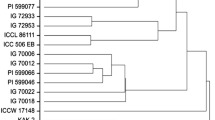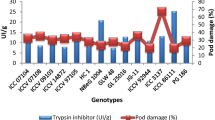Abstract
Eight desi chickpea genotypes of mid-maturity group were screened by using an open-field screening technique. The genotypes ICC-3137, K-850 and ICC-1403 were found to be more susceptible than the others. More eggs were laid and more larvae were recorded on more susceptible genotypes. A low amount of acidity in the leaf extracts of genotypes was found to be associated with susceptibility to gram pod borer, Heliothis armigera (Hubner).
Résumé
Huit variétés de pois-chiche (type Desi) ont été testées pour leur résistance à Heliothis armigera (Lepid. Noctuidae) en plein champs. Les génotypes ICC 3137, K 850 et ICC 1403 se sont avérés les plus sensibles anx attaques de l’insecte. Les variétés présentant une résistance vis à vis de l’insecte sont caractérisées par des exudations foliaires plus acides que celles des variétés plus sensibles.
Similar content being viewed by others
References
Koundal K.K. and Sinha S.K. (1981) Malic acid exudation and photosynthetic characteristics in Cicer arietinum. Phytochemistry 20, 1251–1252.
Lai S.S., Yadava C.P. and Dias C.A.R. (1985) Assessment of crop losses in chickpea caused by Heliothis armigera. FAO Plant Prot. Bull. 33, 27–35.
Lateef S.S. (1985) Gram pod borer (Heliothis armigera) (Hub.) resistance in chickpeas. Agric. Ecosyst. Environ. 14, 95–102.
Lateef S.S. and Reed W. (1983) Grading plant genotypes for their resistance to insect pests in a field screening programme. Paper presented at the National Seminar on Breeding Crop Plants for Resistance to Pest and Diseases, 25–27 May 1983 at Tamil Nadu Agriculture University, Coimbatore, Tamil Nadu, India.
Reed W., Lateef S.S. and Sithanantham S. (1980) Insect Pest Management of Chickpea. InProc. of the International Workshop on Chickpea Improvement, 28 Feb–2 March 1979 at ICRIS AT Centre, Patancheru, A.P., India, pp.179–183.
Rembold H. (1981) Malic acid in chickpea exudate a marker for Heliothis resistance. Int. Chickpea Newsl., ICRISAT 4, 18–19.
Rembold H. and Winter E. (1982) The chemist’s role in host-plant resistance studies. In Proceedings of International Workshop on Heliothis Management, 15–20 Nov. 1981 at ICRISAT Center, Patancheru, A.P., India, pp.241–250.
Sahasrabuddhe D.L. (1914) The acid secretion of gram plant (Cicer arietinum). Imperial Agricultural Research Institute, PusaBull. 45, 1–12.
Singh H. and Sharma S.S. (1970) Relative susceptibility of some important varietiesof gram to Heliothis armigera Hubner. Indian J. Entomol. 32, 170–171.
Author information
Authors and Affiliations
Rights and permissions
About this article
Cite this article
Srivastava, C.P., Srivastava, R.P. Screening for Resistance to Gram Pod Borer, Heliothis Armigera (Hubner), in Chickpea (Cicer Arietinum L.) Genotypes and Observations on Its Mechanism of Resistance in India. Int J Trop Insect Sci 10, 255–258 (1989). https://doi.org/10.1017/S1742758400003477
Received:
Revised:
Published:
Issue Date:
DOI: https://doi.org/10.1017/S1742758400003477




